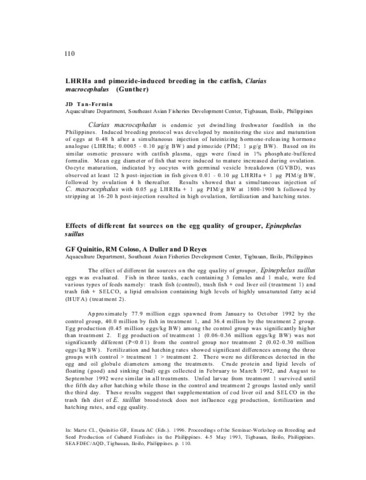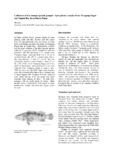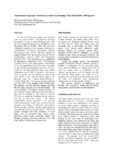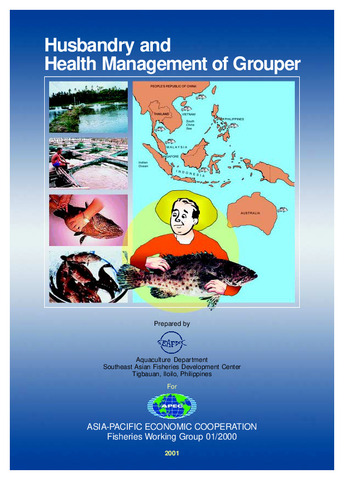Effects of different fat sources on the egg quality of grouper, Epinephelus suillus
| dc.contributor.author | Quinitio, G. F. | |
| dc.contributor.author | Coloso, R. M. | |
| dc.contributor.author | Duller, A. | |
| dc.contributor.author | Reyes, D. | |
| dc.contributor.editor | Marte, Clarissa L. | |
| dc.contributor.editor | Quinitio, Gerald F. | |
| dc.contributor.editor | Emata, Arnil C. | |
| dc.date.accessioned | 2011-08-05T09:28:02Z | |
| dc.date.available | 2011-08-05T09:28:02Z | |
| dc.date.issued | 1996 | |
| dc.identifier.citation | Quinitio, G. F., Coloso, R. M., Duller, A., & Reyes, D. (1996). Effects of different fat sources on the egg quality of grouper, Epinephelus suillus. In C. L. Marte, G. F. Quinitio, & A. C. Emata (Eds.), Proceedings of the Seminar-Workshop on Breeding and Seed Production of Cultured Finfishes in the Philippines, Tigbauan, Iloilo, Philippines, 4-5 May 1993 (p. 110). Tigbauan, Iloilo, Philippines: Aquaculture Department, Southeast Asian Fisheries Development Center. | en |
| dc.identifier.isbn | 9718511326 | |
| dc.identifier.uri | http://hdl.handle.net/10862/570 | |
| dc.description | Abstract only. | en |
| dc.description.abstract | The effect of different fat sources on the egg quality of grouper, Epinephelus suillus eggs was evaluated. Fish in three tanks, each containing 3 females and 1 male, were fed various types of feeds namely: trash fish (control), trash fish + cod liver oil (treatment 1) and trash fish + SELCO, a lipid emulsion containing high levels of highly unsaturated fatty acid (HUFA) (treatment 2). Approximately 77.9 million eggs spawned from January to October 1992 by the control group, 40.0 million by fish in treatment 1, and 36.4 million by the treatment 2 group. Egg production (0.45 million eggs/kg BW) among the control group was significantly higher than treatment 2. Egg production of treatment 1 (0.06-0.36 million eggs/kg BW) was not significantly different (P<0.01) from the control group nor treatment 2 (0.02-0.30 million eggs/kg BW). Fertilization and hatching rates showed significant differences among the three groups with control > treatment 1 > treatment 2. There were no differences detected in the egg and oil globule diameters among the treatments. Crude protein and lipid levels of floating (good) and sinking (bad) eggs collected in February to March 1992, and August to September 1992 were similar in all treatments. Unfed larvae from treatment 1 survived until the fifth day after hatching while those in the control and treatment 2 groups lasted only until the third day. These results suggest that supplementation of cod liver oil and SELCO in the trash fish diet of E. suillus broodstock does not influence egg production, fertilization and hatching rates, and egg quality. | en |
| dc.language.iso | en | en |
| dc.publisher | Aquaculture Department, Southeast Asian Fisheries Development Center | en |
| dc.subject | Epinephelus coioides | en |
| dc.title | Effects of different fat sources on the egg quality of grouper, Epinephelus suillus | en |
| dc.type | Conference paper | en |
| dc.citation.spage | 110 | |
| dc.citation.conferenceTitle | Proceedings of the Seminar-Workshop on Breeding and Seed Production of Cultured Finfishes in the Philippines, Tigbauan, Iloilo, Philippines, 4-5 May 1993 | en |
| dc.subject.asfa | diet | en |
| dc.subject.asfa | fish eggs | en |
| dc.subject.asfa | lipids | en |
| dc.subject.asfa | survival | en |
| dc.subject.asfa | spawning | en |
| dc.subject.asfa | fertilization | en |
| dc.subject.asfa | fish larvae | en |
| dc.subject.asfa | sex hormones | en |
| dc.subject.asfa | feed composition | en |
| dc.subject.asfa | marine fish | en |
| dc.subject.asfa | rearing techniques | en |
| dc.subject.asfa | culture tanks | en |
| dc.subject.asfa | sexual maturity | en |
| dc.subject.asfa | fatty acids | en |
| dc.subject.asfa | oocytes | en |
| dc.subject.asfa | feeding experiments | en |
| dc.subject.asfa | fats | en |
| dc.subject.asfa | standards | en |
| dc.subject.asfa | breeding stock | en |
| dc.subject.asfa | hatching | en |
| dc.subject.scientificName | Epinephelus suillus | en |
このアイテムのファイル
このアイテムは次のコレクションに所属しています
-
Breeding and Seed Production of Cultured Finfishes in the Philippines [31]
Proceedings of the Seminar-Workshop on Breeding and Seed Production of Cultured Finfishes in the Philippines, 4-5 May 1993, Tigbauan, Iloilo, Philippines





